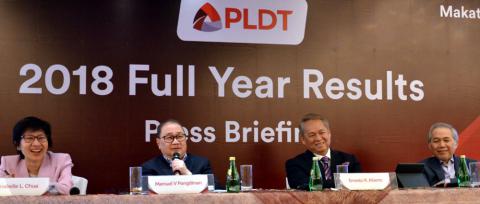
- Sustained double digit growth in Home and Enterprise, turn-around of the Consumer Wireless Business; combined revenue growth of 9%
- Data/broadband anchored the growth -- 60% of Total Service Revenues from 46% in 2017;
- 75%, 64% and 60% of Home, Enterprise and Consumer Individual Revenues, respectively
- Core Income at PHP26.2bn for 2018; Telco Core Income higher by 3% at PHP24.4bn
- Reported Income up 44% to PHP19.2bn
- Consolidated Service Revenues (Net – with International and Voyager) higher by 5% at PHP150.5bn, Telco EBITDA stable at PHP69.2bn, margin of 44%
- CAPEX for 2018 at PHP58.5bn, driving our network quality ahead of competition
- Growth momentum to pick-up in 2019: double digit revenue growth for Home and Enterprise
- 1Q19 revenues for Consumer Individual Business trending at double digit growth
- Telco Core Income guidance at PHP26.0bn, up PHP2.0bn
- CAPEX guidance for 2019 at historic high of PHP78.4bn: to further advance network lead and support vigorous revenue push
PLDT Inc. (“PLDT”) (PSE: TEL) (NYSE: PHI) today announced its unaudited financial and operating results for the full year 2018 with Core Net Income of Php26.2 billion and reported net income of Php19.2 billion. On PFRS15 basis, Core and Reported Income stood at Php25.9 billion and Php18.9 billion respectively.
The impact of the adoption of PFRS15 starting 2018 on the Company’s income statement for the full year 2018 is illustrated in Table 2 on page 8 of this Press Release. For the purpose of an apples-to-apples comparison, the company’s 2018 results discussed below are on a pro-forma PAS 18 basis.
2018 was a breakthrough year for PLDT with all of its main revenue businesses – Home, Enterprise, and Consumer Wireless businesses – firing, each registering robust top line growth.
Consolidated Service Revenues, net of interconnection costs, rose 5% to Php149.4 billion in 2018, excluding Php1.1 billion of revenues from Voyager Innovations (“Voyager”). The combined revenues from our main businesses - Home, Enterprise and Consumer Individual - registered a 9% year-on-year increase to Php137.4 billion.
This marks the return of growth in overall service revenues last recorded in 2014.
Sustaining their robust performance of the past several years, each of Enterprise and Home Groups boosted revenues by 10% -- to Php38.4 billion and Php36.4 billion, respectively.
The big upswing came from the Wireless Consumer Group: after several years of decline and then stabilizing in 2017, the Wireless business registered a 7% rise in revenues to Php62.5 billion in 2018.
Across all business groups, revenue increases were powered by the robust growth in data and broadband. Revenues from data and broadband amounted to Php90.2 billion, up 37% year on year, and accounting for 60% of the total.
Across all business groups, revenue increases were powered by the robust growth in data and broadband. Revenues from data and broadband amounted to Php90.2 billion, up 37% year on year, and accounting for 60% of the total.
“After persistent efforts over the past three years to execute our digital pivot, we have returned our Wireless Consumer Business firmly on the growth path in 2018, alongside our Home and Enterprise businesses which have been consistently posting healthy growth rates. With all cylinders of our revenue engine now firing, we are positioned to throttle into high gear, and do better in 2019,” said Manuel V. Pangilinan, Chairman, President and Chief Executive Officer of PLDT and Smart Communications.
Consolidated EBITDA amounted to Php64.9 billion. Excluding Voyager and Manpower Rightsizing Program (“MRP”) costs, Telco EBITDA was stable at Php69.2 billion year on year due mainly to higher service revenues offsetting increases in cash opex, and subsidies and provisions. Telco EBITDA margin stood at 44%.
Consolidated Core Income was Php26.2 billion which included gains from PLDT’s
loss of control of Voyager and from the sale of Rocket Internet shares offset by
accelerated depreciation arising from our aggressive network transformation programs.
Excluding Voyager operations, Telco Core Income rose by 3% to Php24.4 billion.
Reported Net Income reached Php19.2 billion, up 44% from 2017, as the amount of network swap out costs in 2018 was much less than the prior year.
As of end-2018, Consolidated Net Debt and Net Debt to EBITDA amounted to US$2,357 million and 1.93x respectively. Gross Debt stood at US$3,362 million of which only US$300 million or 8% were unhedged. Fixed-rate loans, post-interest swaps accounted for 89% of total loans while the balance consisted of floating-rate loans. The average pre-tax interest cost was 4.5%.
PLDT’s credit ratings remained at investment grade, and a notch higher than the sovereign, by Standard and Poor’s (“S&P”).
The Take-off Point
In the turnaround journey of the Wireless Consumer Group, the take-off point was its hugely successful Youtube promo launched in April 2018. This special offer gave Smart, TNT and Sun mobile phone customers an hour of free Youtube videos per day when they bought qualified load packages. In the six months that the promo ran, the volume of Youtube traffic in the Smart network soared to nearly 15 times the level at the start of the offer.
Riding on the huge video viewing interest stimulated by the promo, Smart and TNT launched new data packages with built-in “Video Everyday” content offers in the fourth quarter of 2018. As a result, both subscriber take-up and data usage surged further.
By end-2018, mobile data usage had more than doubled year on year to over 820 Petabytes. After registering declines in prior years, the Wireless Business added 2.1 million mobile phone users in 2018, which brought the year-end total to 60 million. Consequently, Individual service revenues grew by 7% year on year to Php62.5 billion on the back of the 62% jump of mobile data revenues to Php37.6 billion, more than compensating for the continued decline of voice and text messaging revenues.
Significantly, the accelerated growth momentum enjoyed by the Wireless Consumer Group in the last quarter of 2018 is carrying into in the first quarter of 2019.
Meantime, PLDT Home revenues continued to be robust despite being held back in installation and repair delivery, arising from the Labor Department Order against PLDT’s service outsourcing arrangements.
Home service revenues grew 10% to Php36.4 billion, powered by the 33% growth year on year of Home Broadband revenues amounting to Php27.2 billion. PLDT Home signed up about 245,000 new broadband customers (mostly for high-value fiber plans) which increased its broadband subscriber count to about 1.9 million. Moreover, it is now well-positioned to sign up more broadband customers in 2019 on account of the extensive roll out of PLDT’s fiber network.
For Enterprise, its topline growth was powered by continued increase in demand for data and digital services. Corporate data revenues were up 13% to Php18.9 billion. Enterprise wireless service revenues were up 24% to about Php7.0 billion, riding on the influx of about 100,000 new postpaid subscribers and another 100,000 Internet of Things (IoT) connections. These wireless data services are being used for transport and logistics through such services as ride hailing/sharing, and, vehicle tracking.
Moreover, the ICT business of Enterprise continued to grow briskly, with revenues rising 14% to Php3.7 billion on the back of its unmatched ability to offer such digital services as data centers, managed IT and cyber security that companies increasingly value.
“Online video viewing – Youtube in the case of mobile, and video on demand for the fixed line – was the compelling offer that powered the strong adoption of our fixed and mobile data services. This worked because, as recent studies show, Filipinos are among the world’s most avid online video viewers. But that would not have been possible if PLDT and Smart had not invested heavily and worked very hard to roll out the country’s best fixed and mobile data networks over the past three years,” said Ernesto R. Alberto, PLDT and Smart Executive Vice President and Chief Revenue Officer.
The country’s best internet
Sustained network investments over the past few years have indeed brought the business to a tipping point in 2018. Capital expenditures reached a new record high in 2018, totaling Php58.5 billion.
As a result, customers have begun to feel the tangible difference between before and now and, between PLDT/Smart and the competition, on both the fixed and mobile broadband. This growing recognition is reflected in the flourishing data business of PLDT and Smart. Further confirmation has come from several crowd-source-based studies on internet services in the country done by third-party organizations such as Ookla, Opensignal and Tutela.
In its latest report covering Q3 and Q4 of 2018, Ookla (the global leader in fixed and mobile broadband network testing and analysis) said that PLDT and Smart are the country’s fastest fixed and mobile networks.
Ookla said Smart earned a Speed Score of 15.57, with an average download speed of 17.86 Mbps and an average upload speed of 8.61 Mbps. Meantime, PLDT fixed broadband attained a speed score of 18.57, with a top download speed of 52.28 Mbps and a top upload speed of 55.95 Mbps. These latest test results are improvements from the scores in Q1 and Q2 2018, when Smart posted a Speed Score of 14.98 and PLDT attained a score of 17.31.
Meanwhile, leading mobile internet analyst firm Opensignal said in its March 2019 report that Smart won four out of its five Mobile Experience Awards – Video Experience, Download Speed, Upload Speed and Latency. The report said that the difference between the two Philippine mobile operators was particularly stark in the video experience category where “Smart users are clearly enjoying better overall video quality, with faster loading times and fewer interruptions during playback.”
In its February 2019 report on the state of mobile networks in Southeast Asia, Canadian crowd-sourced mobile data company Tutela said Smart led the competition based on its metric called “consistent quality score” which tracks the percentage of time users can experience either “excellent” or “basic quality” connections. Tutela reported that Smart posted an excellent quality score of 48.8% versus the competition’s 23.8%. That means Smart users were twice as likely to experience excellent data connections, which are needed for heavy data uses like video viewing.
“Given these independent, third-party studies, it is indisputable that PLDT and Smart are today delivering the fastest and best quality fixed and mobile broadband internet services in the country. We are building on that competitive edge by further investing in our networks in 2019,” said Mario G. Tamayo, Senior Vice President for network planning and engineering for PLDT and Smart.
Historic Capex, Part II
To further enhance their network advantage, PLDT and Smart are undertaking yet another massive capex program by allocating up to Php78.4 billion budget in 2019, or Php20 billion higher than the previous year. This aggressive roll-out is intended to further push the already significant network advantage of PLDT and Smart, and, to support our active campaign for more revenues.
PLDT’s infrastructure edge is most significant in fixed broadband. By end-2018, the coverage of its fiber-powered network passed 6.3 million homes, 57% higher than the 2017 level. Total capacity reached 2.6 million ports with about 1.0 million ports available for sale.
Moreover, PLDT added nearly 70,000 kilometers more of fiber cables, expanding its total fiber network to over 244,000 kilometers, a 39% increase from end-2017.
To take full advantage of on the fixed broadband opportunity, the 2019 capex budget includes a substantial allocation for “Customer Capex”. This is intended for the purchase of last-mile and customer-premises equipment like modems and also the acquisition of vehicles, equipment and office space for the new corps of technicians being assembled to fast-track the installation and repair of fixed broadband connections.
“From a customer experience standpoint, nothing beats fiber. Fortunately, the group has built-up over the years, an unmatched extensive fiber footprint which allows us to reach more homes faster and cost-effectively. This major allocation for customer capex will enable our Home and Enterprise Groups to quickly connect more homes and businesses with fiber-powered fixed broadband using already available fiber ports, provide more customers with better service, and generate additional revenues,” said Oscar A. Reyes, Jr., PLDT Senior Vice President for Consumer Business Market Development.
On mobile, the objective is to build on Smart’s LTE advantage and prepare for the arrival of 5G. In 2018, Smart increased the number of its LTE base stations by over 86% to about 16,200 in 2018. It also increased its 3G base stations by over 17% to about 11,500. This massive deployment has enabled Smart to meet its commitment to the National Telecommunications Commission to provide mobile broadband in at least 90% of the country’s cities and municipalities.
At the same time, Smart has raised the pace of deployment of LTE-Advanced (LTE-A) which offers even faster mobile data speeds through carrier aggregation. This capability of LTE-A combines the capacity of two up to five frequency bands, delivering data speeds of up to 500 Mbps with capable mobile devices like the Samsung Galaxy S9 and S10. Smart has already activated carrier aggregation in about 70% of the LTEequipped cell sites.
Meanwhile, Smart is proceeding with its 5G roll-out after launching the first “Smart 5G cities” in the Clark Freeport Zone in Pampanga, and, at the Makati Central Business District in late 2018. More Smart 5G cities will be set up in 2019 in Metro Manila and other parts of the country.
“This effort is being spearheaded by the Enterprise Group in order to accelerate the development of viable applications for businesses and local governments that can take full advantage of the higher speeds and greater intelligence of 5G. To achieve this, we are working with multiple technology partners to tap the most advanced and effective technology solutions such artificial intelligence and Internet of Things from all over the world,” said Juan V. Hernandez, PLDT Senior Vice President for Enterprise Business.
Ramping Up Digital Payments
In November 2018, Voyager Innovations welcomed as new investors leading global investment firm KKR & Co.; Tencent, a leading global internet-based technology enterprise based in China; and the IFC and IFC Emerging Asia Fund, the investment arm in Asia of the International Fund Corporation of the World Bank Group. These new investors infused US$215 million in new funding for Voyager, the largest investment so far in a Philippine technology company. PLDT remains the largest single shareholder with an ownership stake of just under 50% in Voyager.
Voyager is now using the additional resources to ramp up its efforts to promote digital financial services in the Philippines. In particular, the company is currently focused on further expanding digital payments adoption among customers, enterprises, and communities with PayMaya.
“We are now benefitting not only from the fresh funds but also the global expertise of our new investor partners. This has reinforced PayMaya as the game changer for digital payments and financial inclusion in the Philippines,” said Orlando B. Vea, Voyager President and Chief Executive Officer.
Conclusion
“In 2018, our various digital transformation initiatives finally came together, and enabled us to place PLDT and Smart solidly on the growth track. This effort required considerable investment of effort and resources and persistence has started to acquire traction, as shown by a higher level of internal collaboration than ever before. Our fixed and mobile network roll outs, for instance, produced the targeted results in terms of improved customer experience and higher revenues because of the tighter and more effective coordination all around – between our business and network groups, and, between our fixed and mobile network teams. But there’s still more room for improvement,” Pangilinan said.
“In 2019, we aim to attain a higher level of growth by leveraging even more the power of the combined PLDT and Smart, working as ONE team, focused on delivering the customer experience - not as a traditional telco as we have been - but as a data-driven, digital services company. Given the positive trends in 2018 and our plans for 2019, we expect our Telco Core Income to rise to Php26.0 billion, and, our capex to increase by Php20 billion to Php78.4 billion,” Pangilinan concluded.
Read press release in PDF format.

